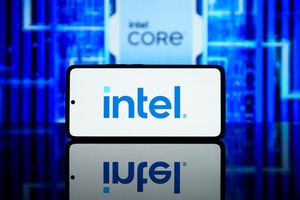
NVIDIA Corporation (NASDAQ: NVDA) stands at the undisputed pinnacle of the artificial intelligence (AI) semiconductor market, maintaining an astonishing 70-95% market share. This unprecedented dominance is not merely a statistical anomaly but a testament to a meticulously crafted ecosystem of hardware and software, fundamentally reshaping the global technology landscape. The company's data center revenue continues its meteoric ascent, fueling an economic engine that analysts project will drive the broader AI infrastructure market into a multi-trillion-dollar industry.
The implications of NVIDIA's pervasive influence are far-reaching, touching every facet of AI development, from cutting-edge research to enterprise-scale deployments. As the demand for AI capabilities intensifies, NVIDIA's role as the primary enabler has profound effects on competitors, partners, and the very pace of technological advancement, setting the stage for both unprecedented innovation and intense market scrutiny.
The Unstoppable Ascent: How NVIDIA Conquered AI's Core
NVIDIA's chokehold on the AI semiconductor market is a story of strategic foresight, relentless innovation, and the creation of an indispensable developer ecosystem. As of Q1 2025, the company commanded an estimated 92-94% market share for data center GPUs, with broader estimates for AI accelerators generally hovering between 70-95%. This commanding lead is rooted in several interconnected factors that have created a virtually unassailable competitive moat.
At the heart of NVIDIA's dominance lies its Compute Unified Device Architecture (CUDA) platform, launched back in 2006. CUDA is far more than just a programming interface; it's a comprehensive software stack comprising libraries, tools, and APIs that enable millions of developers to harness the parallel processing power of NVIDIA's GPUs. With roughly 98% of AI developers utilizing CUDA, it has fostered a powerful "lock-in" effect, making it extraordinarily difficult and costly for companies to migrate their vast AI workloads to alternative architectures. This integrated hardware-software approach ensures optimal performance and efficiency, critical for the demanding calculations of modern AI.
Complementing its software prowess, NVIDIA's hardware innovations are equally formidable. Its Graphics Processing Units (GPUs), particularly the A100 and H100 (Hopper architecture), have become the industry standard for training and deploying large language models (LLMs) and other complex AI applications. These GPUs feature specialized Tensor Cores designed to accelerate the matrix operations fundamental to AI algorithms. The company's rapid innovation cycle, now accelerating its AI GPU product launches to an annual cadence, exemplified by the upcoming Blackwell and Rubin architectures, keeps competitors perpetually playing catch-up. NVIDIA's data center segment has been the primary beneficiary of this demand, with revenue reaching $41.1 billion in Q2 FY2026, a 56% year-over-year increase. While data center compute revenue saw a slight sequential dip of 0.9% in Q2 FY2026, networking revenues (including InfiniBand and Ethernet) nearly doubled to $7.25 billion, signaling an evolving investment focus towards the interconnects necessary for massive AI clusters. Furthermore, strategic partnerships with major cloud providers such as Microsoft (NASDAQ: MSFT) Azure, Amazon (NASDAQ: AMZN) Web Services, and Google (NASDAQ: GOOGL) Cloud, coupled with a significant allocation of TSMC (NYSE: TSM) advanced chipmaking capacity, solidify NVIDIA's supply chain and market penetration.
The AI Gold Rush: Who Wins and Who Struggles
In the AI gold rush, NVIDIA (NASDAQ: NVDA) is unequivocally the pickaxe seller, reaping immense benefits from every shovel swung in the pursuit of artificial intelligence. The most direct winners are NVIDIA itself, whose market capitalization has surged past $4 trillion, driven by seemingly insatiable demand for its chips. Cloud service providers (CSPs) like Microsoft (NASDAQ: MSFT), Amazon (NASDAQ: AMZN), and Google (NASDAQ: GOOGL) are also significant beneficiaries, as they invest billions in NVIDIA's GPUs to power their AI infrastructure offerings. These CSPs then rent out access to NVIDIA-powered AI compute, offering scalable solutions to countless businesses and developers. AI developers and researchers, too, are major winners, as NVIDIA's powerful and ubiquitous hardware and software ecosystem provides the necessary tools and performance to push the boundaries of AI innovation without having to re-engineer foundational infrastructure.
On the other side of the ledger, competitors face an uphill battle. Advanced Micro Devices (NASDAQ: AMD), despite making strides with its Instinct MI300X series, and Intel (NASDAQ: INTC), with its Gaudi accelerators, are struggling to erode NVIDIA's deeply entrenched position. The sheer breadth and maturity of NVIDIA's CUDA software ecosystem create a formidable barrier to entry, as migrating existing AI models and development workflows to alternative platforms is a costly and time-consuming endeavor. These companies are forced to play catch-up, investing heavily in both hardware development and ecosystem building, often while NVIDIA is already moving to its next generation of products.
Furthermore, smaller chip startups attempting to enter the AI accelerator market face immense challenges in securing foundry capacity, attracting top talent, and convincing developers to switch from a proven and widely supported platform. The significant capital expenditure required to compete in this arena, combined with the network effects of NVIDIA's ecosystem, means that while there's a burgeoning market, capturing a meaningful share remains incredibly difficult for new entrants. The recent news of NVIDIA investing $5 billion in Intel and partnering to co-develop AI infrastructure and PC products, while a positive for Intel shares, also underscores NVIDIA's strategic move to further expand its influence across the compute landscape, potentially limiting independent growth avenues for other competitors.
Reshaping Industries: Broader Implications and Regulatory Scrutiny
NVIDIA's (NASDAQ: NVDA) near-monopoly in AI semiconductors has profound implications that extend far beyond its balance sheet, fundamentally shaping the direction of the broader AI industry. Its dominance dictates the underlying infrastructure upon which most advanced AI models are built, effectively setting industry standards for performance, efficiency, and development workflows. This concentration of power raises concerns about potential bottlenecks in AI development, as innovation could become increasingly dependent on a single vendor's product roadmap and pricing strategies. The ability to rapidly scale AI depends heavily on access to NVIDIA's latest chips, creating potential supply chain vulnerabilities and pricing pressures for smaller AI companies and even large enterprises.
The rapid ascendancy and critical importance of NVIDIA's technology have also attracted significant regulatory and geopolitical scrutiny. Governments worldwide are increasingly aware of the strategic importance of AI infrastructure. In particular, the U.S. government's export controls on advanced AI chips to China have directly impacted NVIDIA, leading to a reported $5-10 billion annual revenue loss and necessitating the development of China-specific, downgraded chip designs. This geopolitical tension highlights how NVIDIA's commercial success is intertwined with international relations and national security interests, potentially forcing the company to navigate complex political landscapes alongside its technological advancements.
Historically, dominant technology companies have often faced antitrust challenges. While NVIDIA's control is largely due to superior innovation and execution rather than predatory practices, its sheer market share could invite closer examination from regulatory bodies concerned about fair competition. Comparisons can be drawn to Microsoft's (NASDAQ: MSFT) antitrust battles in the 1990s over its Windows operating system, though the AI hardware market is arguably more dynamic. Nevertheless, the risk of regulatory intervention or increased scrutiny remains a palpable factor that could influence NVIDIA's long-term strategy and market behavior. The ongoing shift in data center spending towards interconnected AI clusters, where NVIDIA's InfiniBand and Ethernet solutions are also gaining traction, further solidifies its control over not just compute but the entire AI fabric, intensifying these broader implications.
The Road Ahead: Navigating Growth and Challenges
Looking ahead, NVIDIA (NASDAQ: NVDA) is poised for continued robust growth, fueled by the accelerating global demand for artificial intelligence. CEO Jensen Huang envisions AI infrastructure evolving into a $3-$4 trillion sector by 2030, with a projected $1 trillion shift in data center spending towards GPU-driven AI over the next few years. Analysts echo this optimism, forecasting NVIDIA to achieve $206 billion in revenue for fiscal year 2026, a substantial 58% increase from the previous year, with earnings per share projected to grow at a compound annual rate of nearly 35% through fiscal years 2025-2028. Some even predict the company could reach an astounding $10 trillion market capitalization by 2030, driven by revolutionary new GPU classes designed for sophisticated AI applications in areas like software development and video generation.
However, this trajectory is not without potential challenges and strategic pivots. The most immediate challenge is intensifying competition. While NVIDIA currently enjoys a dominant position, rivals like Advanced Micro Devices (NASDAQ: AMD) and Intel (NASDAQ: INTC) are committed to developing competitive hardware and software ecosystems. NVIDIA's recent $5 billion investment in Intel, alongside a partnership for AI infrastructure and PC products, could be interpreted as a strategic move to secure foundry capacity, expand its ecosystem, and perhaps preemptively address competitive threats or regulatory concerns by collaborating with a historical rival.
Furthermore, geopolitical tensions, particularly U.S. export controls to China, remain a significant hurdle. NVIDIA's ongoing need to design specific, compliant chips for the Chinese market could dilute its technological edge and complicate its global supply chain. The company is strategically expanding into new verticals beyond traditional data centers, focusing on "physical AI" in robotics and autonomous vehicles, where its automotive division has already seen significant growth. These emerging markets represent crucial long-term opportunities but also require substantial investment and new strategic adaptations to maintain leadership in diverse and rapidly evolving fields.
A New Era of Computing: NVIDIA's Lasting Imprint
NVIDIA's (NASDAQ: NVDA) unparalleled dominance in AI semiconductors marks a pivotal moment in the history of computing, fundamentally altering how artificial intelligence is developed and deployed globally. The confluence of its industry-leading hardware, embodied by its powerful GPUs, and the virtually indispensable CUDA software ecosystem, has created a formidable barrier to entry, propelling the company to the forefront of the AI revolution. Recent record-breaking data center revenues, culminating in a staggering $41.1 billion in Q2 FY2026, underscore the insatiable demand for its technology, cementing its status as an economic powerhouse and a critical enabler of the AI age.
Moving forward, NVIDIA's strategic moves—from its aggressive innovation cycle and expansion into "physical AI" to its significant investment in former rival Intel (NASDAQ: INTC)—demonstrate a company keenly aware of its market position and the need to both capitalize on opportunities and mitigate risks. While challenges such as mounting competition and geopolitical export controls will test its resilience, NVIDIA's foundational role in AI infrastructure ensures its lasting impact. The company is not just building chips; it is constructing the very foundation of future industries.
Investors should closely watch NVIDIA's continued data center revenue growth, particularly the balance between compute and networking segments, as this reflects evolving AI infrastructure demands. The success of its new architectures (Blackwell, Rubin) and its strategic diversification into robotics and automotive AI will be key indicators of sustained long-term growth. Furthermore, any developments concerning regulatory scrutiny or the competitive landscape will be crucial in assessing NVIDIA's ability to maintain its commanding lead in what promises to be a trillion-dollar AI economy. The company's story is a testament to the power of a full-stack approach in creating enduring technological leadership.






